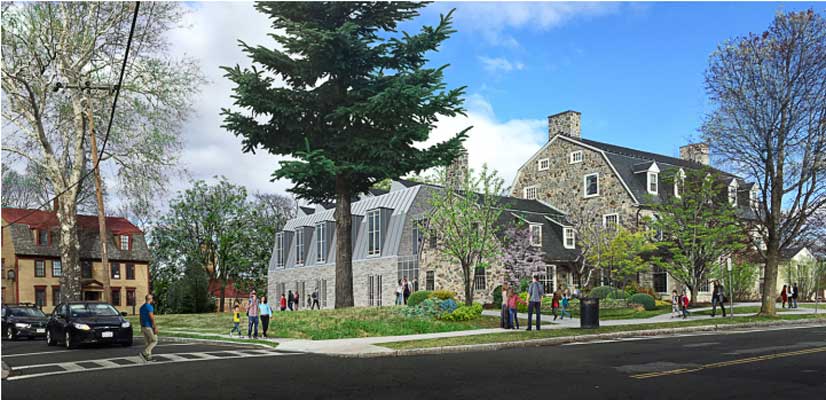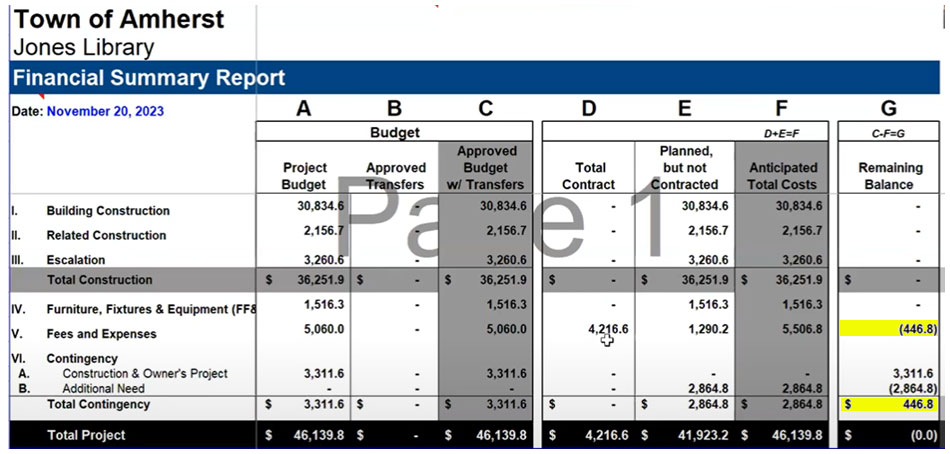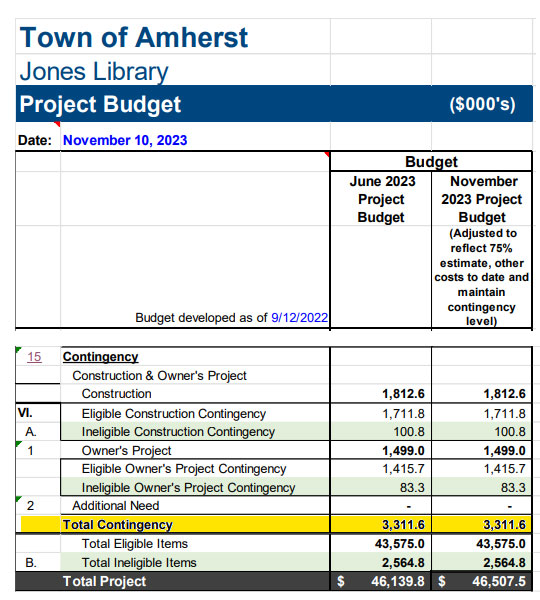New Report Shows Library Project Contingency Funds Exhausted

Updated Financial Summary Omitted From Councilor Packet During Additional Borrowing Debate
At the Jones Library Building Committee (JLBC) meeting of November 27, Owner’s Project Manager Tim Alix of Colliers presented an updated library building Financial Summary. A notable change was the marked reduction of Total Contingency – an amount budgeted to cover unforeseen costs, risks and escalations that may affect the project’s ultimate cost. Contingency typically represents 5-10% of a total library construction project budget.

The updated Financial Summary showed Total Contingency which had originally been budgeted at $3.311 million now reduced to $446,800 due to planned “Additional Need” To balance the budget, this contingency total is further needed to offset a budget overrun of $446,800 in Fees and Expenses. The report appears to leave nothing budgeted for future unforeseen expenses.
The updated Financial Summary was not included in the packet for the December 4 Town Council meeting where a vote on authorizing the borrowing of an additional $9.8 million for the $46.1 million library project was scheduled. The supplemental borrowing had been recommended in a 3-1-1 vote by the Finance Committee on November 28.
See related Opinion: Finance Committee Drops the Ball on Due Diligence
During the town council discussion, Councilor Pam Rooney proposed placing an absolute cap on the use of taxpayer funds at the current level in the event of further cost escalation when bids are received early next year. On November 27 the full town share of the library project cost was projected to be $24,888,342 including principal and interest payments.
Councilor Cathy Schoen expressed confidence that the project budget included a large enough contingency allowance to cover unanticipated cost increases between now and when bids come in.
“In terms of the most recent estimates there’s still a healthy contingency fee in there. There’s a buffer if the basic estimates are somewhat off […] so I think we’re on pretty good financial ground,” she said.
However, Schoen appeared to be working off a November 10 Project Budget distributed to council members and not the November 27 Financial Summary from the JLBC meeting.
The older $3.311 million contingency figure before reduction by “Additional Need” was also communicated to the Finance Committee in a Q&A document read by Council President Lynn Griesemer at the November 28 Finance Committee meeting where the supplemental borrowing was recommended.
Councilor Ellisha Walker found the Q&A answers insufficient and reported sending the Town Manager a request for additional information she needed to make an informed decision on more borrowing. An updated 5-year cash flow is needed, she said, in order to understand how borrowing another $9.8 million might impact the schedules for the new DPW and fire station projects.
Griesemer rebuffed Walker’s request saying, “Those questions in fact were recorded. They are on the [additional Nov. 27] Q&A and are answered to the best of our ability to provide them.”
Regarding impacts to the capital projects, the Q&A says “This is a work in progress and will require additional time. However, a brief analysis indicated that there is not much change from what the Finance Committee saw in Spring 2023 meaning that we are still on the same track regarding the Fire/EMS station south of downtown and the DPW.”
After hearing Schoen’s confidence that project contingency was adequate, Town Manager Paul Bockelman, who had been present at the JLBC meeting where the reduced contingency was first reported, did not correct her understanding.
When project manager Alix presented the Financial Summary to the JLBC, he did not talk about the drawdown of contingency and commented that “things are looking good.”


I’d like to say as a ‘survivor’ of a medical emergency thanks to our Police and EMS, please RE-Prioritize our taxpayer funds to support an updated Fire Department Building which was supposed to be updated over twenty plus years ago. Since the lack of tax support from the college and lack of industries in Amherst, the tax burden is placed almost entirely on private home owners. Let’s keep ‘them’ alive and give our First Redponders the respect they deserve.
Bruce Cuddy
Thanks, Jeff. It is so challenging to track the finances of this project. Unfortunately, the Jones Library Building Committee asked no questions of the OPM when the financial summary was presented. The meeting where this document was presented was over in 19 minutes.
Video: https://youtu.be/weREU5CY84M?si=Uhhr5ughVlTWf82R&t=625
I would love to know the breakdown of the $2,864,800 “Additional Need” line in this financial summary dated 11/20/23.
Can anyone explain what it is for?
At the bottom of the OPM’s screen when he displayed the financial summary, you could see “Transfers from VI. Contingency to I.A Construction” but whatever was below that was not visible.
Several town councillors, when they were rebuffed at this past Monday’s Amherst Town Council meeting for seeking a delay in the decision to authorize additional borrowing for the Jones Library demolition/expansion, diplomatically suggested they were trying to “get to Yes” by pausing until their next meeting. And it proved wise to express that optimistic possibility: after considerable debate, the vote to postpone carried easily by a 10-3 supermajority.
While “getting to Yes” is always more satisfying psychologically, any rational decision-making process must also consider “getting to No” as a possibility as well; these latest revelations about the depletion of the Jones demolition/expansion contingency fundshould give us further pause, figuratively as well as literally — and perhaps permanently.
A contingency fund to less than 1% of a large project budget (not including debt service — another big unknown in light of higher interest rates and volatility in the municipal bond markets) seriously calls into question the rationality of the decision making: the failure of the “Owner’s Project Manager” to assess this makes on wonder “who is the “Owner” and the failure of the Town Manager to promptly correct a misunderstanding about this at last Monday’s meeting raises many more questions.
Starry-eyed optimism is a psychological coping mechanism that sometimes works out in personal matters (just google “delulu is the solulu” for the most modern examples); however, it can be downright dangerous in public affairs: the absence of “getting to No” is not merely a symptom of delusional thinking, it can lead to malfeasance and its serious consequences (viz. the elected officials in Bell, California, where were, after all, elected —before they were convicted).
We can do better than this — and on this tortured project “getting to Never” may prove be the best option.